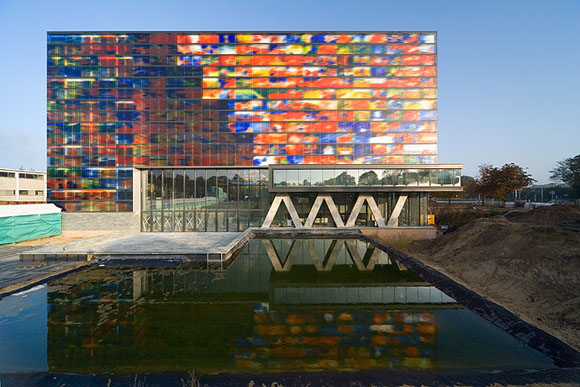July 29, 2007
the bnw of sg
That is... the Brave New World of Stained Glass.

Two architectural glass projects with an eye to the future.
On the left, the south transept window by Gerhart Richter for Cologne Cathedral, in Cologne, Germany.
On the right, the new building by Neutelings Riedijk Architects for the Netherlands Institute for Sound and Vision in Hilversum, The Netherlands.
Gerhard Richter Window at Cologne Cathedral
It's not often you see an article about stained glass in WIRED magazine. Such is the case with the new window designed by Gerhard Richter for Cologne Cathedral.
Why in WIRED? Wired points out that 4096, the name of the painting on which the window is based, is also the number of 'web-smart' colors. So, we have computer types geeking out on numerical coincidence. Nevertheless, there is something distinctly 'computery' about the look of the design.
Why? To my eyes, it's because it looks so much like an image of random pixels on a computer screen; and interesting seeing that the painting was created in 1974, before the invention of personal computers or programs like photoshop.
This is the original Richter painting from 1974 called 4096, featuring a grid of 64 x 64 squares and, presumably, 4,096 distinct colors.

This image was made by taking a random image and putting the 'noise' filter on it in photoshop, then zooming in tight. Aside from the color palette being more skewed toward magenta than red, I think the resemblance is striking.

The Cologne window is constructed of 11,500 pieces of glass in approimately 4 inch squares, chosen from 72 colors. Looking at this page (in German), it would appear to be constructed without leadlines, most likely with some form of lamination. I'll update if I find more info on this.
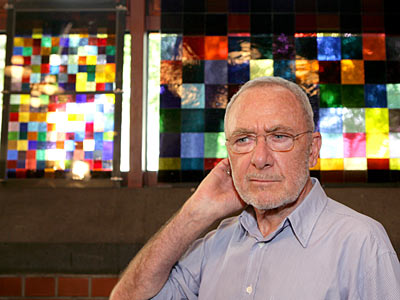
I also came across a flickr page with a tantalizing close up of the window, but no info. Also, another article, in German.
[update- August 28, 2007 - An article stating that the Cologne Cathedral window was officially unveiled on Saturday, August 25, 2007. There is a photo gallery, though the article does not mention any additional technical details about method of construction.]
[update August 29, 2007 - a page containing a link to a hi res image]
The Netherlands Institute of Sound and Vision
I suppose that it was only a matter of time before the glass curtain wall became the stained glass curtain wall.
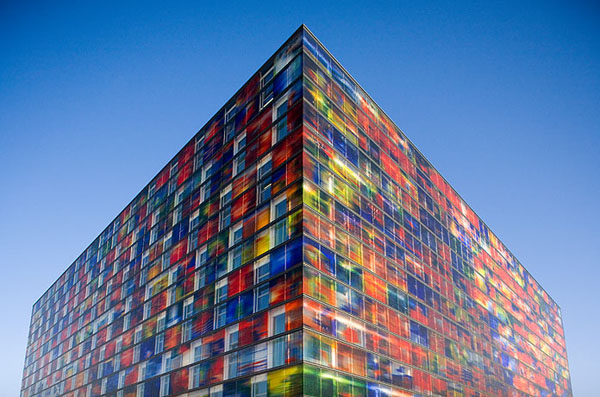
and an interior view -

More on the Netherlands Institute here and here, as well as a New York Times review of the Museum of Sound and Vision
The architects worked with the graphic designer Jaap Drupsteen who refers to it only as NIBG, short for Nederlands Instituut voor Beeld en Geluid.
This is the only detail I could find of the imagery that is shaped into the cast glass panels. The images apparently relate to Netherlandish media over the decades as Hilversum is the center for television production in the Netherlands.

Again, photo by Iwan Baan
On top of this, there is this very interesting interior wall with more photographic imagery. I assume this was done with a light acid etch or sandblast.

Finally, this image from the flickr set 'NIBG' by michelicto makes it clear that the glass was manufactured at St. Gobain.

July 25, 2007
A Color Lesson

West Wind is a painting by Winslow Homer, located at the Addison Gallery of American Art, in Andover, Massachusetts.
What does it have to do with stained glass?
The LaFarge connection -
"Charles L. Homer told me that sometime before painting The West Wind, Winslow had been dining with John LaFarge in New York; the two were devoted friends but had many conflicting ideas about art, especially in the field of color. LaFarge criticized Winslow for using too much brown and said his paintings were too dull-toned. Unlike Homer, he was an avowed admirer of European techniques, especially the rich color of the Venetians. Winslow wagered him a hundred dollars that he could paint a picture in browns which would be accepted and admired by critics and the public as well. After Reichard, the dealer who exhibited The West Wind, had reported to Homer the obvious popularity of the work, Winslow wrote to LaFarge: "The West Wind" is brown. It's damned good. Send me your check for $100."the quote is from this page of footnotes.
I've been to the museum and seen the painting - it is damned good. I particularly like the fact that there is one shot of bright color in the painting - the signature.

July 20, 2007
Star of David Blog
A blog entirely devoted to images and stories related to the Star of David.
The variety of images and wealth of information on what would seem a narrow subject is astonishing. On top of this there are more than a dozen references to stained glass incorporating the Star of David. Very interesting all around.
I've always been intrigued by the idea of how different designers in different situations incorporate and interpret the same idea or image or symbol. I'm also interested as I've done my own variation on a Star of David in stained glass.
one of the stained glass images featured on the blog -
Stained glass panel from Cimetière du Montparnasse, Paris, France

image via flickrite fugue
The hebrew lettering in the center represents the word for 'peace'.
July 16, 2007
St. Louis City-Wide Open Studios
fyi - I will be participating in the second annual St. Louis City-Wide Open Studios Weekend. My studio will be open on Saturday, July 21.
There is also a St. Louis Open Studios Blog, which includes a list of participating artists with links to their websites and preview images as well. You can download a pdf of the map here.
Definitely a step in the right direction for the St. Louis art scene.
July 14, 2007
Radical Ornamentalist SG in the UK
from Leo Reynold's Photos.
Said to be from St George Tombland, Norwich, Norfolk, England, UK
but I could find no further info.

full pattern field
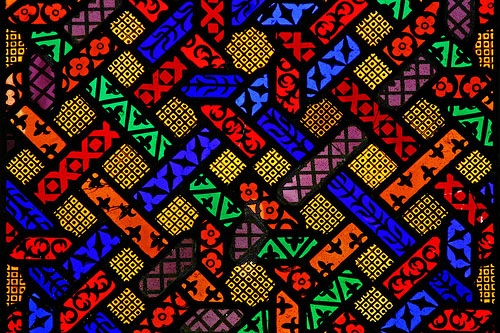
I like.
July 10, 2007
Recent Bottle Walls on Flickr
Curious that there seems to be more and more bottle walls and bottle houses popping up on the web, especially on Flickr. All these are from Flickr and all were posted in the past 3-4 months -
anonymous close up

First of all, a few sites I'd heard of but never found images for -
Pioneertown, CA
this is at Pappy and Harriet's Pioneertown Palace (though no mention of the bottle walls on their website)
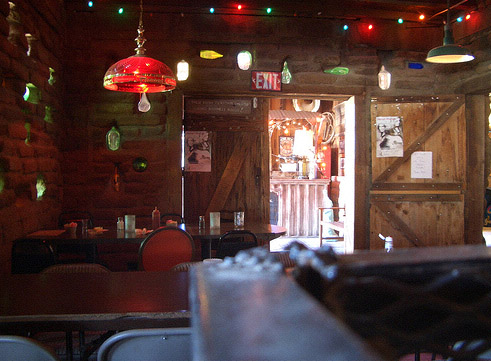


Calico House
The Ghost Town in Calico, California. I'd seen a few images of this house before but not in such a wide range of angles.





Prince Edward Island
I'd heard of these three bottle houses on Prince Edward Island Canada by Edouard Arsenault before but, again, I simply hadn't stumbled upon quite so many images before... and you get many more images with a Flickr search of Prince Edward Island Bottle. These are just a few recent images...

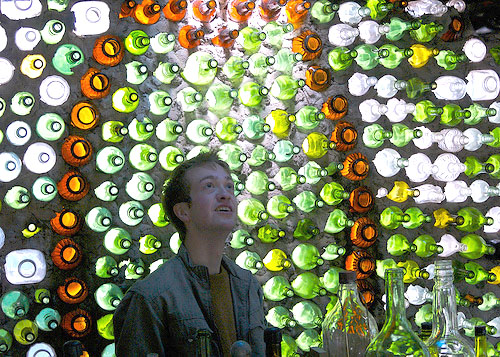

Earthship house
Part of a set from a couple building their won earthsip house in New Mexico.

UK Bottle Dome
outside of the roof of the bottle dome in the waste and recycling zone of the Centre for Alternative Technology in Wales -


The New Zealand Bottle Wall Thing
Why New Zealand as the new vanguard of bottle wall/house creation? Is it the remoteness?, the eccentricity of the populace?, a 'green' revolution?, or the Hundertwasser influence? - or some combination of all? In any case, there seems to be a great deal of bottle wall activity happening in New Zealand.
Wellington New Zealand Bottle House

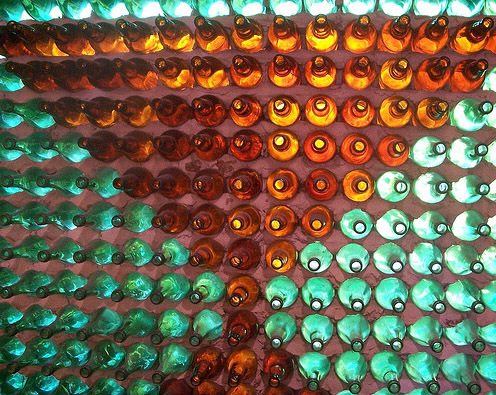

The Hundertwasser influence in New Zealand
A New Zealand art studio with a small bottle wall in the style of Hundertwasser.


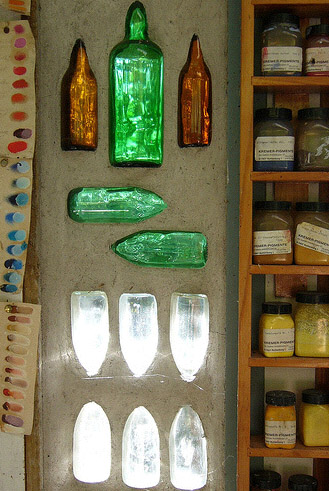
Another New Zealand Hundertwasser style small bottle wall.

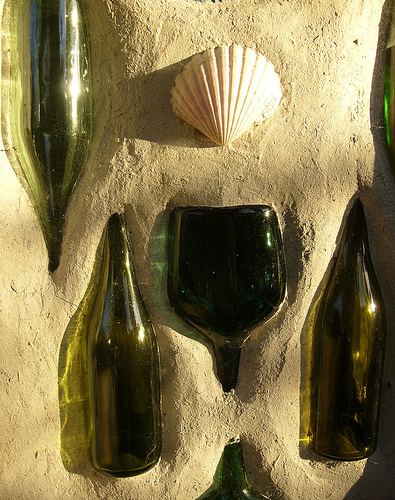
Carlucci Land -
Detail photos of a bottle wall in New Zealand at Carlucci Land, a sculpture park in Wellington.
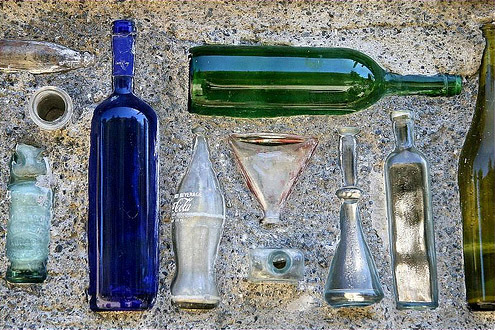

finally -
the New Zealand Composting Toilet
doubly inspired by Hundertwasser...

